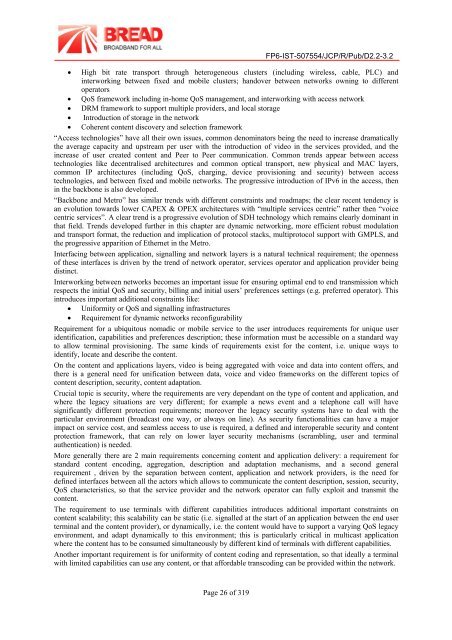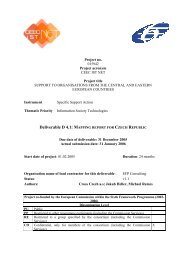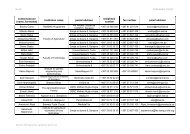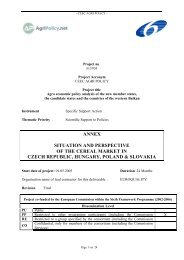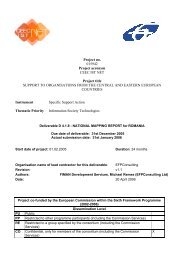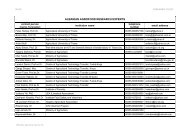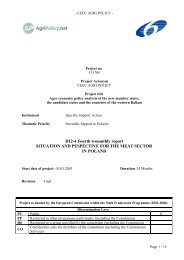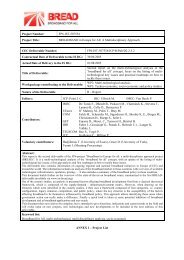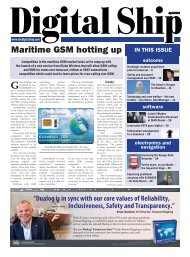Project Number: FP6-IST-507554 Project Title: BROADBAND in ...
Project Number: FP6-IST-507554 Project Title: BROADBAND in ...
Project Number: FP6-IST-507554 Project Title: BROADBAND in ...
Create successful ePaper yourself
Turn your PDF publications into a flip-book with our unique Google optimized e-Paper software.
Page 26 of 319<br />
<strong>FP6</strong>-<strong>IST</strong>-<strong>507554</strong>/JCP/R/Pub/D2.2-3.2<br />
• High bit rate transport through heterogeneous clusters (<strong>in</strong>clud<strong>in</strong>g wireless, cable, PLC) and<br />
<strong>in</strong>terwork<strong>in</strong>g between fixed and mobile clusters; handover between networks own<strong>in</strong>g to different<br />
operators<br />
• QoS framework <strong>in</strong>clud<strong>in</strong>g <strong>in</strong>-home QoS management, and <strong>in</strong>terwork<strong>in</strong>g with access network<br />
• DRM framework to support multiple providers, and local storage<br />
• Introduction of storage <strong>in</strong> the network<br />
• Coherent content discovery and selection framework<br />
“Access technologies” have all their own issues, common denom<strong>in</strong>ators be<strong>in</strong>g the need to <strong>in</strong>crease dramatically<br />
the average capacity and upstream per user with the <strong>in</strong>troduction of video <strong>in</strong> the services provided, and the<br />
<strong>in</strong>crease of user created content and Peer to Peer communication. Common trends appear between access<br />
technologies like decentralised architectures and common optical transport, new physical and MAC layers,<br />
common IP architectures (<strong>in</strong>clud<strong>in</strong>g QoS, charg<strong>in</strong>g, device provision<strong>in</strong>g and security) between access<br />
technologies, and between fixed and mobile networks. The progressive <strong>in</strong>troduction of IPv6 <strong>in</strong> the access, then<br />
<strong>in</strong> the backbone is also developed.<br />
“Backbone and Metro” has similar trends with different constra<strong>in</strong>ts and roadmaps; the clear recent tendency is<br />
an evolution towards lower CAPEX & OPEX architectures with “multiple services centric” rather then “voice<br />
centric services”. A clear trend is a progressive evolution of SDH technology which rema<strong>in</strong>s clearly dom<strong>in</strong>ant <strong>in</strong><br />
that field. Trends developed further <strong>in</strong> this chapter are dynamic network<strong>in</strong>g, more efficient robust modulation<br />
and transport format, the reduction and implication of protocol stacks, multiprotocol support with GMPLS, and<br />
the progressive apparition of Ethernet <strong>in</strong> the Metro.<br />
Interfac<strong>in</strong>g between application, signall<strong>in</strong>g and network layers is a natural technical requirement; the openness<br />
of these <strong>in</strong>terfaces is driven by the trend of network operator, services operator and application provider be<strong>in</strong>g<br />
dist<strong>in</strong>ct.<br />
Interwork<strong>in</strong>g between networks becomes an important issue for ensur<strong>in</strong>g optimal end to end transmission which<br />
respects the <strong>in</strong>itial QoS and security, bill<strong>in</strong>g and <strong>in</strong>itial users’ preferences sett<strong>in</strong>gs (e.g. preferred operator). This<br />
<strong>in</strong>troduces important additional constra<strong>in</strong>ts like:<br />
• Uniformity or QoS and signall<strong>in</strong>g <strong>in</strong>frastructures<br />
• Requirement for dynamic networks reconfigurability<br />
Requirement for a ubiquitous nomadic or mobile service to the user <strong>in</strong>troduces requirements for unique user<br />
identification, capabilities and preferences description; these <strong>in</strong>formation must be accessible on a standard way<br />
to allow term<strong>in</strong>al provision<strong>in</strong>g. The same k<strong>in</strong>ds of requirements exist for the content, i.e. unique ways to<br />
identify, locate and describe the content.<br />
On the content and applications layers, video is be<strong>in</strong>g aggregated with voice and data <strong>in</strong>to content offers, and<br />
there is a general need for unification between data, voice and video frameworks on the different topics of<br />
content description, security, content adaptation.<br />
Crucial topic is security, where the requirements are very dependant on the type of content and application, and<br />
where the legacy situations are very different; for example a news event and a telephone call will have<br />
significantly different protection requirements; moreover the legacy security systems have to deal with the<br />
particular environment (broadcast one way, or always on l<strong>in</strong>e). As security functionalities can have a major<br />
impact on service cost, and seamless access to use is required, a def<strong>in</strong>ed and <strong>in</strong>teroperable security and content<br />
protection framework, that can rely on lower layer security mechanisms (scrambl<strong>in</strong>g, user and term<strong>in</strong>al<br />
authentication) is needed.<br />
More generally there are 2 ma<strong>in</strong> requirements concern<strong>in</strong>g content and application delivery: a requirement for<br />
standard content encod<strong>in</strong>g, aggregation, description and adaptation mechanisms, and a second general<br />
requirement , driven by the separation between content, application and network providers, is the need for<br />
def<strong>in</strong>ed <strong>in</strong>terfaces between all the actors which allows to communicate the content description, session, security,<br />
QoS characteristics, so that the service provider and the network operator can fully exploit and transmit the<br />
content.<br />
The requirement to use term<strong>in</strong>als with different capabilities <strong>in</strong>troduces additional important constra<strong>in</strong>ts on<br />
content scalability; this scalability can be static (i.e. signalled at the start of an application between the end user<br />
term<strong>in</strong>al and the content provider), or dynamically, i.e. the content would have to support a vary<strong>in</strong>g QoS legacy<br />
environment, and adapt dynamically to this environment; this is particularly critical <strong>in</strong> multicast application<br />
where the content has to be consumed simultaneously by different k<strong>in</strong>d of term<strong>in</strong>als with different capabilities.<br />
Another important requirement is for uniformity of content cod<strong>in</strong>g and representation, so that ideally a term<strong>in</strong>al<br />
with limited capabilities can use any content, or that affordable transcod<strong>in</strong>g can be provided with<strong>in</strong> the network.


